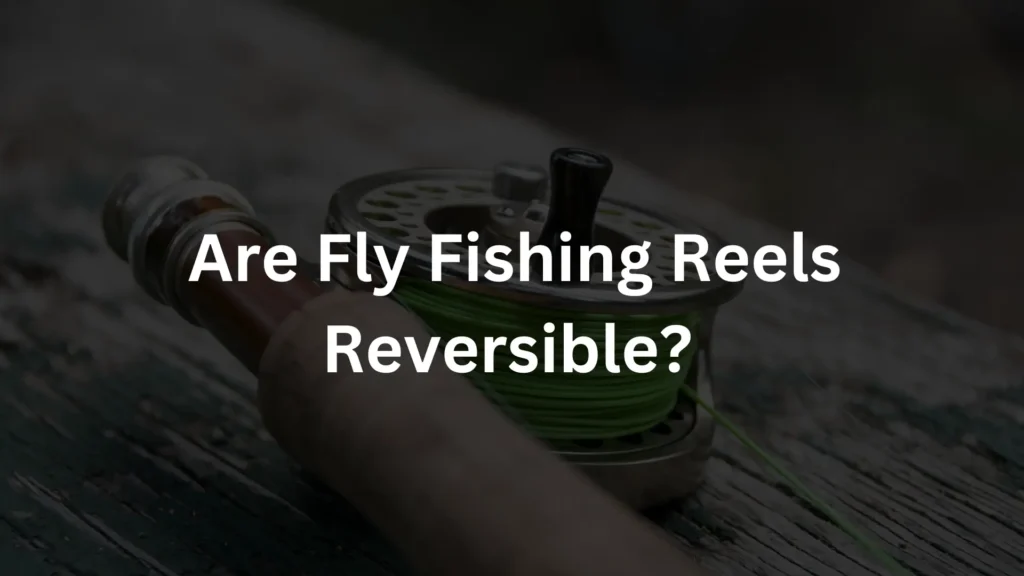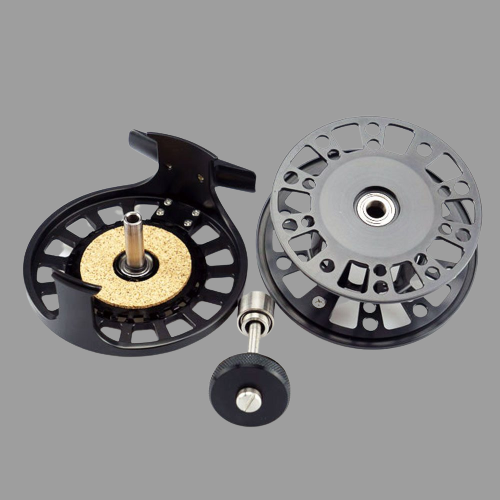
Fly fishing is a unique and skillful sport, where selecting the right gear can make or break your experience. One commonly asked question, especially among novice fly fishermen, is are fly fishing reels reversible? In other words, can you switch between left hand retrieve and right hand retrieve on a fly reel? I’m here to provide a clear and definitive answer.
The short answer is yes, fly fishing reels are reversible. Most fly reels available today come with a clutch bearing, which allows them to be easily switched from right hand retrieve to left hand retrieve and vice versa.
It’s important to select a comfortable setup for your dominant hand – one that feels natural when reeling in fish or casting. Typically, right-handed anglers will have a left hand retrieve, and left-handed fishermen will go with the right hand setup. But, of course, there’s no right or wrong way as long as you feel comfortable and confident in using your preferred method.
So, why would you want to switch your fly fishing reel?
A couple of reasons come to mind. Firstly, switching hands may become necessary if a big fish, like a salmon or large trout, is putting up a good fight and you need to quickly switch your rod hand to the other side for more control.
Secondly, trying a new setup could potentially improve your casting and overall technique, especially if you’re targeting fish such as smallmouth bass or larger fish that demand a strong and steady hand. Ultimately, it’s about finding what works best for you and adapting your equipment to suit your needs.
Table of Contents
Understanding Fly Fishing Reels
Are fly fishing reels reversible? This question is essential to know for both beginners and experienced anglers, as the reel is a crucial component of the fly fishing setup. To address this inquiry, it’s necessary to delve deeper into the workings of fly reels and the factors that influence their reversibility.
Types of Hand Retrieves in Fly Fishing
Fly fishing reels are mainly designed to hold the fly line and backing, as well as provide drag against the fish when it tries to swim away. There are two kinds of hand retrieves in fly fishing: left hand retrieve and right hand retrieve.
Left hand retrieve reels are operated with the left hand, while right hand retrieve reels are cranked with the right hand. Various factors, such as personal preference and comfort, dictate which hand retrieves an angler chooses.
Reversibility of Fly Fishing Reels
While some reels have fixed hand retrieves, many modern fly fishing reels are indeed reversible. Reversibility refers to the ability to switch the reel’s retrieve direction, essentially transforming a left-hand retrieve reel into a right-hand retrieve one or vice versa.
This functionality is particularly useful for those who prefer to use their dominant hand for casting and their non-dominant hand for reeling.
Steps to Reverse a Fly Reel
To reverse a fly reel, you typically have to access the one way clutch bearing. This metal component is found inside the reel’s main body and determines the retrieve direction. By carefully flipping the clutch bearing, you can change the hand retrieve of the reel.
Benefits of Reversible Fly Reels
The option of reversing a reel has several benefits:
- Improved comfort for anglers who want to switch their hand retrieve based on personal preference or to adapt to different fishing situations.
- Easier transitions for those who have recently acquired a new setup and need to adjust it to their desired hand retrieve.
- More versatile reels for anglers who wish to share their gear with others who have different hand retrieve preferences.
Personal Preferences and Reel Setups
There isn’t necessarily a right or wrong way to set up your reel, as it largely depends on personal preference and comfort.
Legendary angler Lefty Kreh advocated for the use of the non-dominant hand for reeling, explaining that it makes sense to use the dominant hand for casting and maintaining control of the fly rod.
Read More: What is a streamer in fly fishing?
The Mechanics of Reversing a Reel
Fly reels play a crucial role in the art of fly fishing, helping you cast and control your fly line. The ability to switch the retrieve direction of a fly fishing reel caters to different angler preferences or situations.
This feature allows you to select either a left hand retrieve or a right hand retrieve, depending on your dominant hand or comfort.
When the fly reel is manufactured, the clutch bearing determines the direction of the reel’s drag, which offers resistance when a fish is fighting against the line. Reversing the retrieve means switching the configuration of this clutch bearing, enabling the reel to turn in the opposite direction.
Here are the steps to reverse a reel:
- First, remove the spool from the fly reel by pushing the release switch located either at the center or the side.
- Next, you’ll notice a one way clutch bearing inside the reel body that looks like a round metal piece with a hole in the center.
- Carefully remove the clutch bearing and pay attention to the orientation.
- Flip the clutch bearing to face the opposite direction, making sure it’s seated correctly in place.
- Finally, slide the spool back onto the fly reel, and you’re ready to go.
Remember, whether you prefer a right hand retrieve or a left hand retrieve, most modern fly fishing reels can be easily adjusted to your preference.
Types of Reversible Fly Reels
When considering whether are fly fishing reels reversible, it’s important to recognize that most fly reels can, indeed, be switched between left hand retrieve and right hand retrieve. In here, I’ll take you through different types of reversible fly reels that you may encounter during your fly fishing adventures.
Firstly, let’s discuss some common fly reels. These reels typically have a one-way clutch bearing that enables them to switch between left and right hand retrieves.
With a reversible clutch bearing, it makes sense for a fly fisherman to have a reel that can be easily adjusted to their dominant hand. This comes in especially handy when fighting big fish or needing to switch hands during intense moments on the water.
Some popular reversible reels include the following:
- Disk drag fly reels
- Spring and pawl fly reels
- Click drag fly reels

To switch the retrieve on these fly fishing reels, you often just need to flip the spool, reverse the clutch bearing, or slide a switch to the desired retrieve. These methods are quite simple and can often be done without any specialized tools.
Now, let’s address some fly reels specifically designed for certain scenarios. For instance, when targeting large fish like salmon or trout, some anglers opt for a larger fly reel with a good drag system.
A reversible fly reel with proper retrieving capabilities can prove to be essential in turning these hefty fish away from snags and effectively fighting them.
However, it’s important to note that some spinning reels aren’t reversible. Spinning reels, often used for trout fishing or smallmouth bass, have a distinct mechanism that prevents them from being switched between left and right hand retrieves. These reels may not be a feasible option when trying to create a comfortable setup with your fly rod.
Read More: Difference between fly fishing and regular fishing rods
Switching from Left-Hand to Right-Hand Retrieve
To switch the retrieve on a fly fishing reel, you’ll typically follow these steps:
- Remove the spool from the reel frame.
- Locate the one way clutch bearing, which controls the direction of the reel’s drag.
- Carefully flip the clutch bearing to the desired orientation.
- Reassemble the spool and frame, making sure everything is properly aligned.
- Test the retrieve to ensure it’s functioning correctly in the new orientation.
It’s important to note that some older models or certain budget fly fishing reels may not have this feature, but the majority of modern fly reels allow for this adjustment.
Beginners to fly fishing may wonder if there’s a right or wrong way to set up their reel. In truth, it mostly comes down to personal comfort and what feels most natural.
When it comes to choosing between a left hand or right hand retrieve, many fly fisherman, like Lefty Kreh, recommend using the hand that’s opposite of your casting hand to reel in fish.
For example, if you cast with your right hand, you’d want your reel set for a left hand retrieve. This can provide a more stable and efficient fishing experience, as it allows you to maintain control of your fly rod while reeling in a catch.
However, there are always exceptions based on personal preference. Some anglers may find that they feel more comfortable reeling with their dominant hand, even if it requires switching hands during the process of fighting fish.
Additionally, some situations may call for a specific setup – for instance, battling large fish like salmon or smallmouth bass could benefit from having a good drag system and controlling the reel with the angler’s dominant hand.
Pros and Cons of Reversible Reels
Having a reversible fly fishing reel can provide a level of versatility and convenience, particularly for beginners or those who change hands during a fight with big fish. However, the process of reversing the retrieve direction can be complicated and might even lead to errors if not done correctly.
The choice of whether to opt for a reversible fly reel comes down to personal preference and comfort level. If you’re unsure, it’s always best to try out both options and choose what works best for your own fly fishing style.

Pros of Reversible Reels
- Versatility: Reversible fishing reels cater to both left-handed and right-handed anglers, enabling them to switch up their hand retrieve with ease. Whether you have a dominant left hand or right hand, a reversible fly reel allows for a comfortable setup while casting.
- Good for Switching Hands: Reversible fly reels make switching hands a smoother process. Some anglers may flip their fly rod to the other hand while fighting a fish, and having the option to switch the retrieve on the reel makes it more efficient.
- Helpful for Beginners: Newcomers to fly fishing might not be entirely confident in their retrieve preference, and a reversible reel offers a chance to experiment with different retrieve options.
Cons of Reversible Reels
- Complexity: Changing the retrieve direction on a fly reel can sometimes be a complicated process, especially without prior experience. It may involve disassembling parts of the reel, flipping the one way clutch bearing, and reassembling the reel accordingly.
- Increased Chance of Errors: Reversing the retrieve direction on your fly reel opens up the possibility of making errors while reinstalling the spool, clutch bearing, or other parts. This could lead to a malfunctioning reel or potentially even damaging the reel.
- Not Always Necessary: Many fly fishermen find that they can become accustomed to a specific retrieve direction and stick with it throughout their fishing career. For them, having a reversible reel might not make a significant difference.
Read also: Can you fly fish with a spinning rod?
Conclusion
So, are fly fishing reels reversible? As I’ve explored throughout this article, the answer is yes, most modern fly reels are indeed reversible. Switching between left hand retrieve and right hand retrieve enhances the angler’s usability and comfort on the water.
Fly fishermen have their own preferences, and as an angler, I can attest that it’s essential to have a comfortable setup. Trout fishing, smallmouth bass fishing, and chasing larger fish such as salmon may require different tactics, but the ability to reverse a fly fishing reel remains a valuable feature.
